Lesson Eight – Lawrence Edwards’ Man of Stones
INTRODUCING LAURENCE EDWARDS
Laurence Edwards was born in Suffolk in 1967. After leaving school with two O Levels, he went to Lowestoft Art College, and it was there, as he later said, that he found his feet. He went on to study at Canterbury College of Art and then at the Royal College of Art, where he trained in bronze casting and sculpture with Sir Anthony Caro. After winning a Henry Moore Bursary, the Angeloni Prize for Bronze Casting and an Intach Travelling Scholarship, he studied traditional casting techniques in India and Nepal. This equipped him with the knowledge and skills to set up his own metal foundries back in the UK.
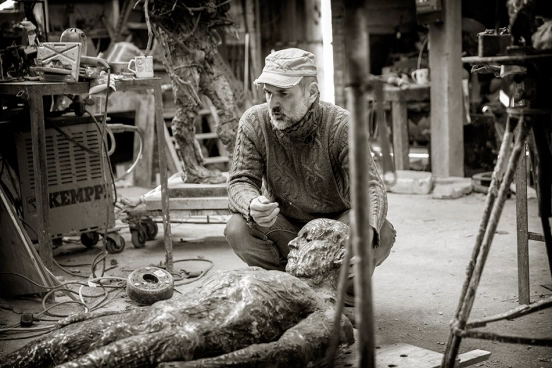
In 2003, Edwards, along with artists Keir Smith, Chris Summerfiled, Sian O’Keeffe and Stuart Anderson, founded Butley Mills Studios, a bronze foundry and artists’ studios set in the marshlands of the Butley Creek in Suffolk. The facilities and wild location have drawn many artists to work there, including Chrisopher Le Brun and Caroline Wright. The opportunity to experiment with the lost-wax cast process in his own foundries over the course of his career has allowed Edwards to create a distinct language, drawing on the deep relationship of bronze to history, art and culture.
In 2008, Edwards created three eight-foot bronze figures inspired by the Suffolk salt marshes around Butley Mills Studios. Having decided that his works wouldn’t work so well in an art gallery, he started to see the landscape from which they had come as the natural place to site them. A raft was built to take them up the River Alde to just beyond Snape Maltings as part of the Aldeburgh Festival. They were positioned so that they would stand waist high in the mud at low tide, and float at high tide. In a film made by the festival to capture this process, Edwards talks of how the perception of bronze as an obsolete material chimed with his interests in the impermanent, fragile landscape of coastal East Anglia, and it’s lost, defeated ways of life. His figures both embody the idea of decay and transience, and, at the same time, of new life and a permanence gained through being cast in metal.
Edwards was elected a Fellow of the Royal Society of British Sculptors in 2012.
The last work made by Edwards at Butley Creek was A Thousand Tides in 2017. This eight-foot prone male figure, inspired by Mantegna’s Dead Christ, was made to be ‘lost’ in the marshes, as an offering back to the place. In a film made to document this work by Phil Cairney, Edwards talks of how the process of gathering organic material from the landscape and incorporating it into the work means that ‘the figure is the landscape.’ Again, a ritual element was important. A raft was made for the piece and it was taken out into the creek and lowered into the mud.
In 2018, Edwards began work on ‘A Rich Seam’, commissioned by Doncaster Council, and funded with donations from a community crowdfunding campaign. It celebrates the lives of miners who worked in the collieries around Doncaster. Unlike earlier works, which represent a kind of ‘everyman’, these works are portraits, depicting forty former miners who told their stories to Edwards whilst being sculpted. These sessions were filmed by Doncaster College for their online archive. A Rich Seam was installed in Doncaster city centre In February 2021. Keith Marshall, one of the miners depicted, said that “this will be something that my grandchildren can take their grandchildren to, and learn our history’.
In November 2019, Edwards made Man of Stones, a site specific work for the Sainsbury Centre sculpture park. It stands between the broad and the river Wensum, where the campus merges into the surrounding landscape.
In November 2021, Edwards completed Yoxman. At twenty-six feet high and weighing eight tonnes, it is his largest work to date. Cast under the supervision of his Foundry Manager, Tom Crompton, it is one of the largest bronze sculptures to be cast in the UK in recent years. As with other works, this piece incorporates organic material, and is sited next to the A12 near Cockfield Hall in the village of Yoxford, Suffolk. Edward’s has described the work as “a Green Man for our age’ and “a lightning rod for loads of issues about ecology and what we are doing to this planet.” In the artist’s blog post, documenting the installation of the piece, Edwards writes:
To my delight he appeared like a piece of the natural world. As I’d hoped the cliffs at Covehithe and Dunwich were there in the forms and surfaces. It seemed this figure was eroding before my eyes…
In his photographs illustrating the blog post, Edwards shows the work obscured by a tree, reflected in a lake, and the view from the A12, with cars rushing by, then stopping as the people inside peer at this new feature in the landscape. The work, dubbed the “Suffolk Colossus”, has recently attracted widespread attention in the local and national press.
Edwards has cited Anthony Caro and Tissa Ranasinghe as sculptors who have influenced his work. Elsewhere, he talks of the very wide range of sources he taps into for inspiration, including: literature, biology, medicine, philosophy, archaeology, and the Suffolk landscape where he lives and works; often collapsing the boundaries between them. He sees strong parallels, for example, between human biological systems, river systems, and the fluid process of working with molten metal.
Edwards currently works with a team of around ten people, running two studios in Suffolk, one, with a Foundry, in Halesworth, and the other in a converted Fire Station in Saxmundham.
GETTING YOUR EYE IN
Using the app, launch the sculpture in AR and move around it. Then look at the 180 degree videos to get a sense of how the sculpture is placed in its parkland setting.
If you don’t have the app, use the image gallery below.
As always, give yourself time to really look. Allow the work time to come to you, letting it be, letting yourself be, allowing your encounter to unfold naturally.
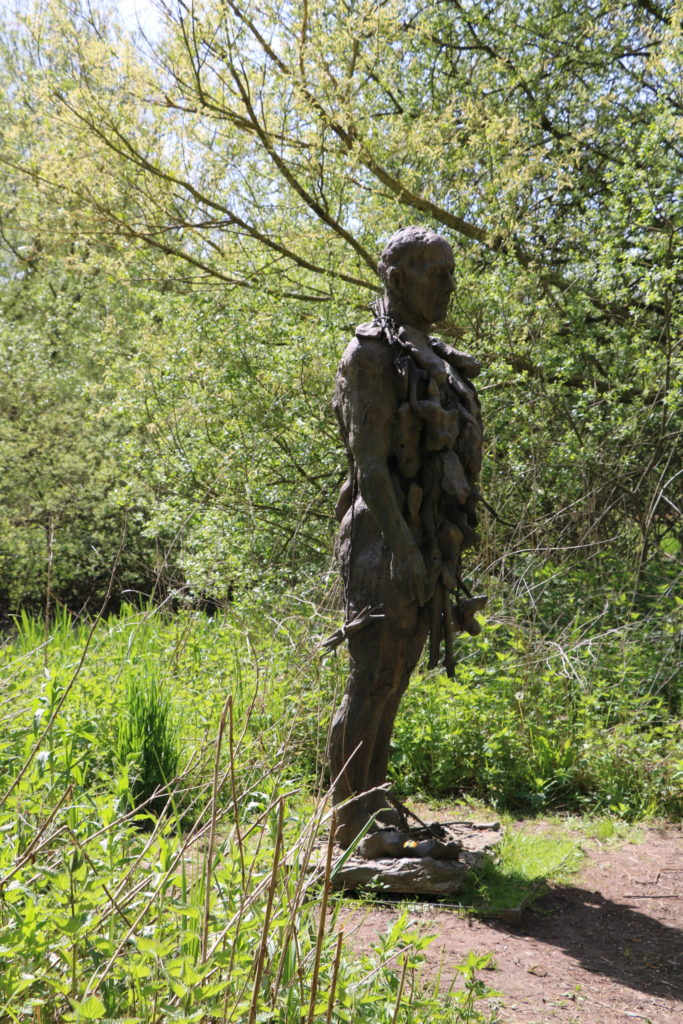
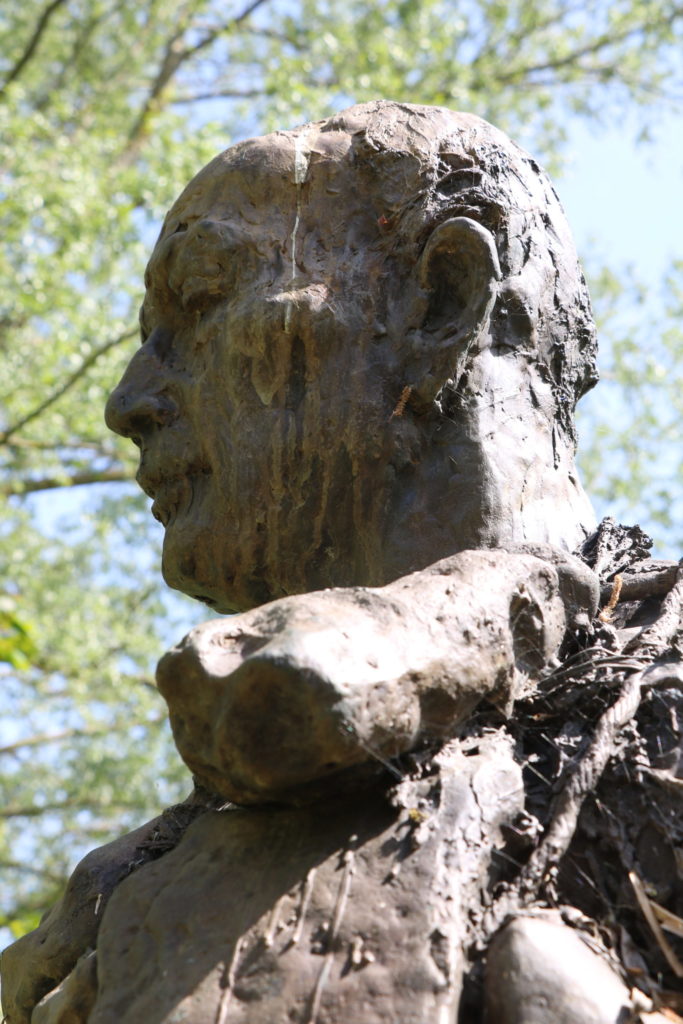
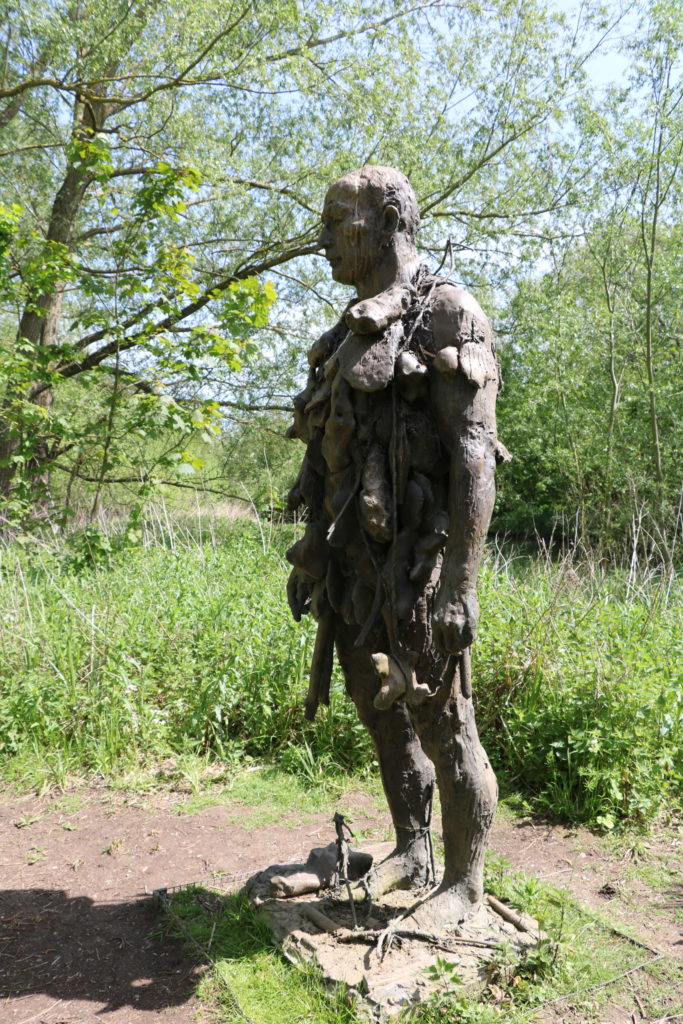
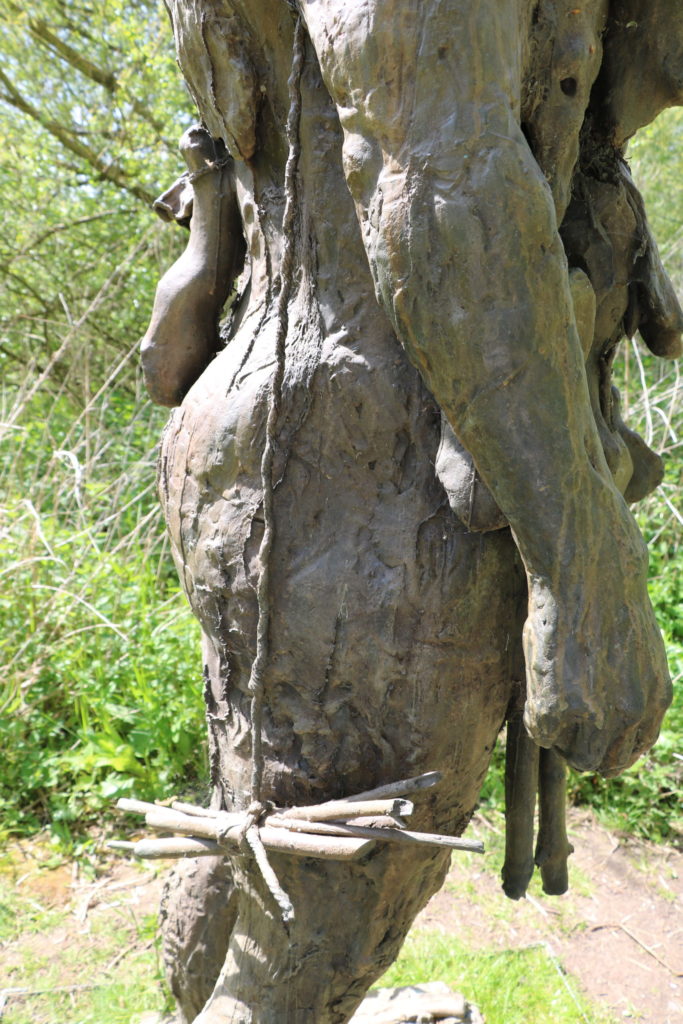
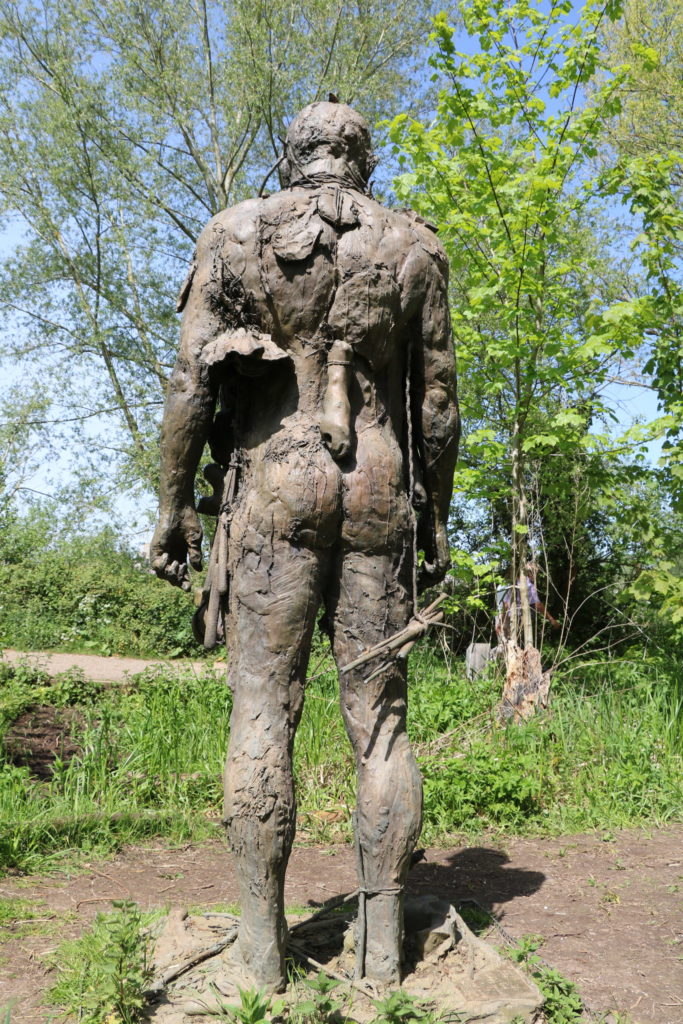
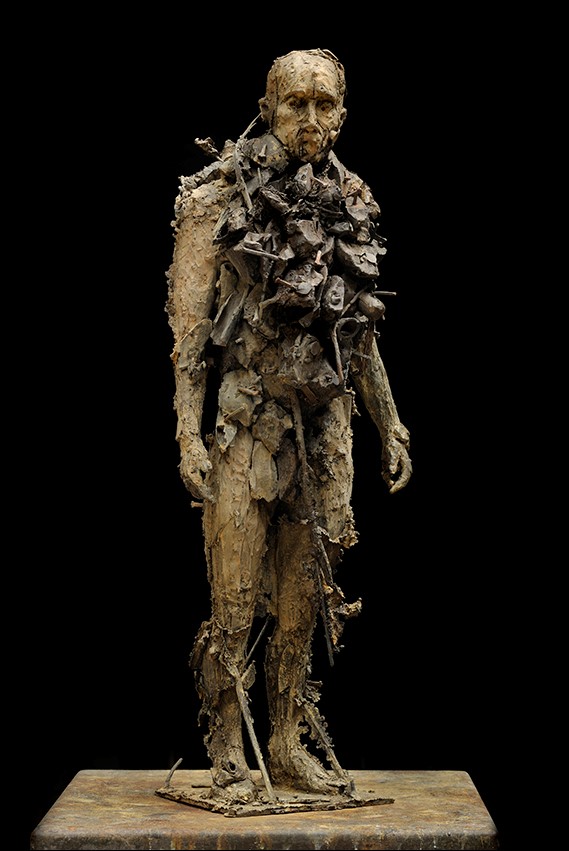
ACTIVITY 1
Now watch this video where I take you on a walk along the path towards Man of Stones. As you are watching, think about the moment it comes into view. Imagine all the different sensations you might be experiencing if you were there in person: sight, smell, sound, touch.
Jot down your thoughts and impressions.
ACTIVITY 2
Imagine you are visiting Man of Stones with the artist beside you. What questions might you want to ask him? Note them down.
FROM THE ARTIST’S PERSPECTIVE
Now let’s see what the artist, himself, says. Watch this film made with Laurence for the Sainsbury Centre documenting his site specific work for our sculpture park. Then take a look at the quotes below. What questions do they answer? What new ones do they suggest?
WATCH THIS VIDEO
“The figures are about how it feels to be someone like me. They are in a sense equivalents. I don’t work from a model. I often find myself feeling a wrist or a clavicle, looking at a calf or neck tendon in the mirror. Ultimately my figures are the sum of a set of independent observations adding up to surmise how it ‘feels’ to be me.”
“My work talks of a human relationship to the earth. This, however, is implicit and there is no real environmental or political agenda. Small works like Feel The Heat depict a figure with his hand flat on the floor; it’s as though he is taking a temperature and realising things are changing. This is as close as it gets to politics.
Larger works like Catcher, Carrier and Sylvan Man talk more of a connectedness, where the figure fuses with nature and it also speaks of ancient myth, alluding to times when relationships with nature were more direct. The Catcher fans out and traps organic material as if from an ebbing tide, a monitor or barometer perhaps of the condition of our environment. The Carrier carries sticks, maybe burnt; the remnants of a structure or material to build a new one. Sylvan Man is impregnated with sticks and pinned together with wire and string; a survivor perhaps of a life, a journey, somewhere other, the outback or some such.
These are all just thoughts rather than explanations; in the end the viewer can interpret them as they wish.”
From: Interview with Elli Walsh for Artist Profile, April 22, 2018
GUEST PODCAST
With your own thoughts and questions still in mind, listen to this podcast with Dr Tom Greaves, Associate Professor of Philosophy at the University of East Anglia. His research focuses on philosophical traditions that engage with our lived experience of the natural world. Tom made this wonderful podcast sharing his thoughts about Man of Stones as part of our New Perspectives series.
As you are listening, think about the distinctive ways of looking and thinking that Tom is sharing with us. Note down any new insights, thoughts, or feelings about the sculpture that arise for you as you’re listening.
READING
I really like this essay on Laurence Edwards by Robert MacFarlane, ‘Laurence Edwards: An Essay by Robert Macfarlane’, from Caught by the River, 18th May 2016. I hope you enjoy as much as I did the way that MacFarlane skillfully weaves together his own encounter with the sculptures, his knowledge about Edward’s creative practice, and his interest in the myths and histories that the works evoke.
When you’ve finished reading, go back to Man of Stones. Add to your own notes any new observations or reflections.
OPTIONAL ASSIGNMENT
Taking inspiration from Tom Grieves and Robert McFarlane, rework the notes you’ve made during this lesson into a short piece entitled ‘Encountering Man of Stones’. You might like to think of it as a blog post, or a short article for a local paper or magazine. Don’t overthink it. Just treat it as a ‘thought experiment’ and see where it takes you. The main thing is to capture your thoughts as you imagine yourself as a living, breathing figure in a landscape encountering this other figure in a landscape.
FURTHER EXPLORATIONS
As I said at the beginning of the lesson, Edwards is a fantastic documenter of his own work, so there is plenty of wonderful material to be found online.
He has a monthly blog that he has kept since 2016: laurenceedwards.wordpress.com
And you can generally find his films on Youtube. At the time of writing, his film for A Thousand Tides can be found here; https://youtu.be/6XFYDvEB4V8
And his film for Creek Men here: https://youtu.be/5UTiVVDIjxw
You can also find an interview with Edwards for Great British Life in 2016 here: An interview with Laurence Edwards | Great British Life
